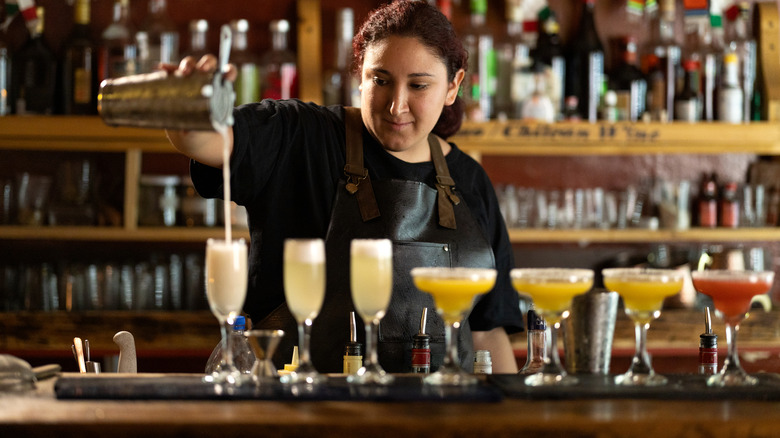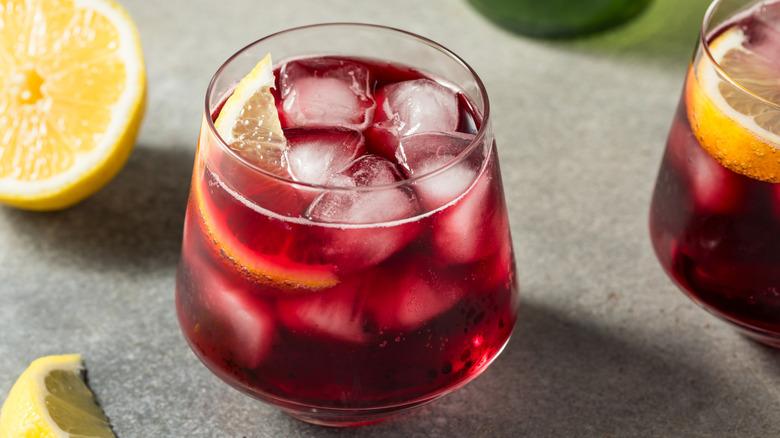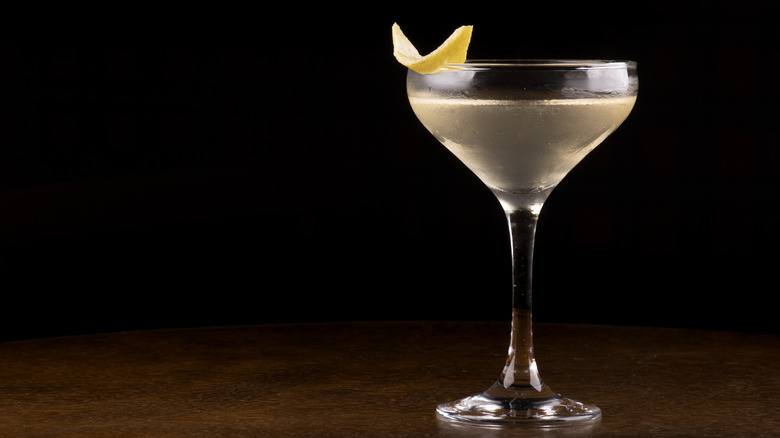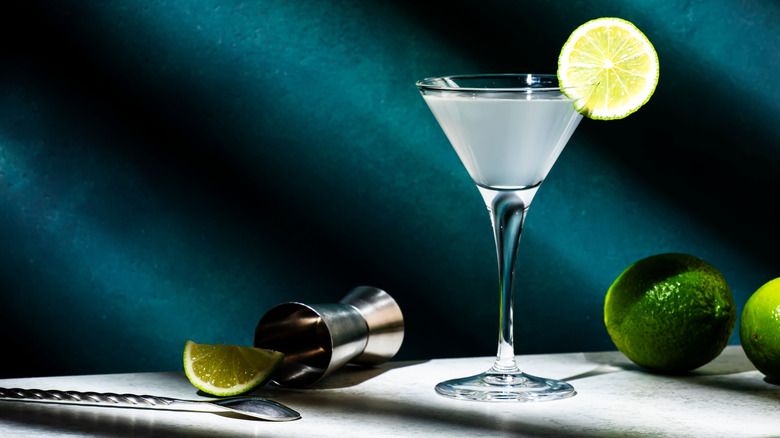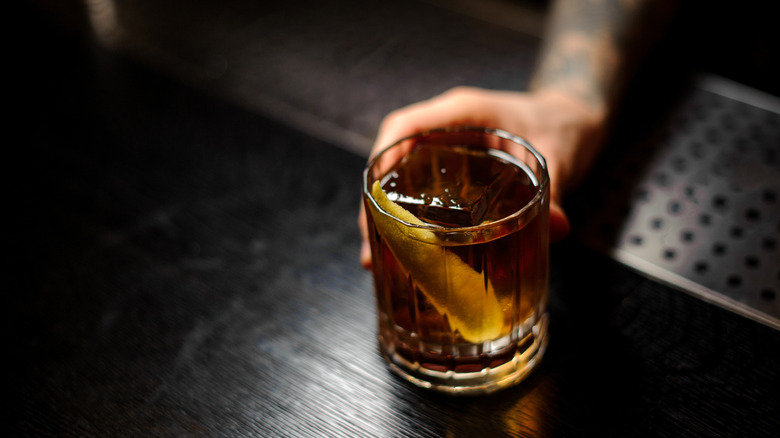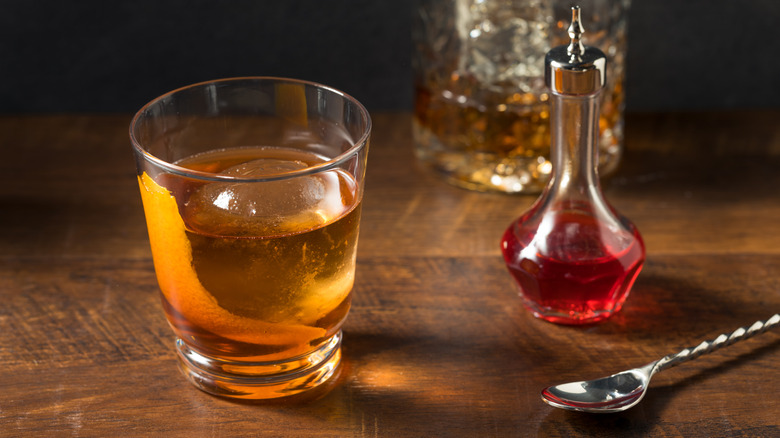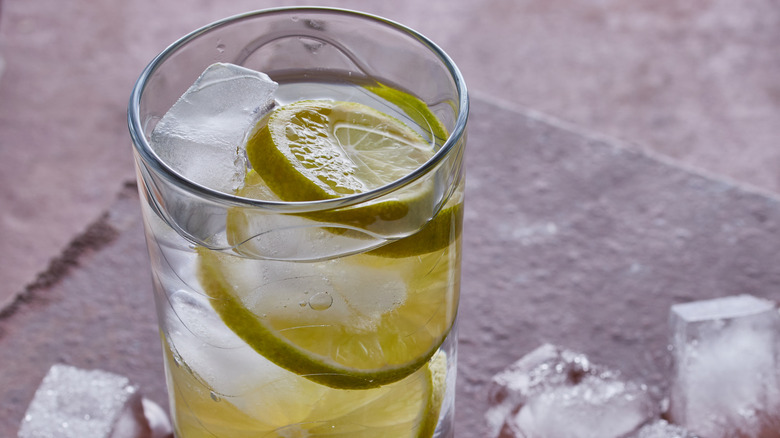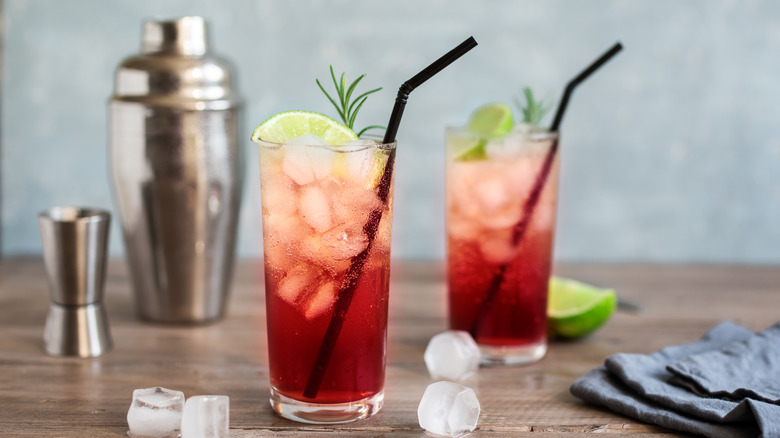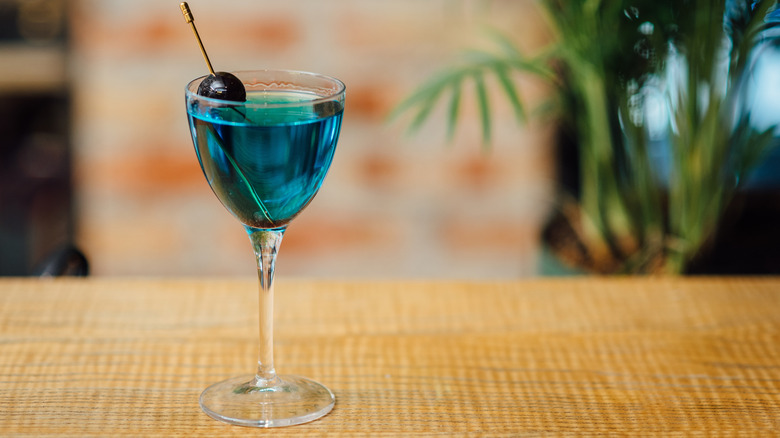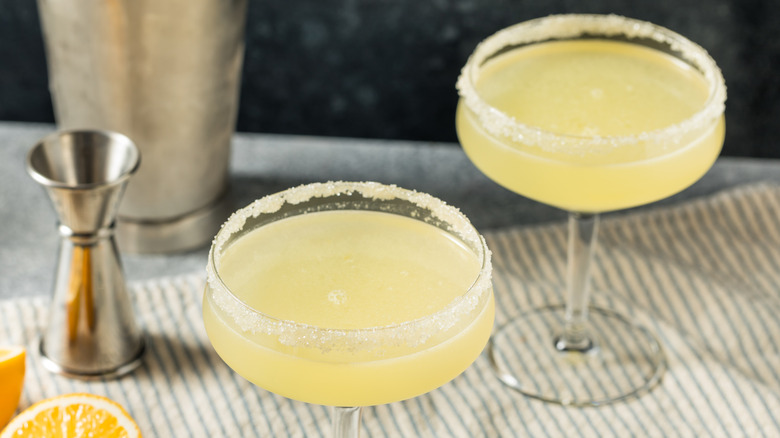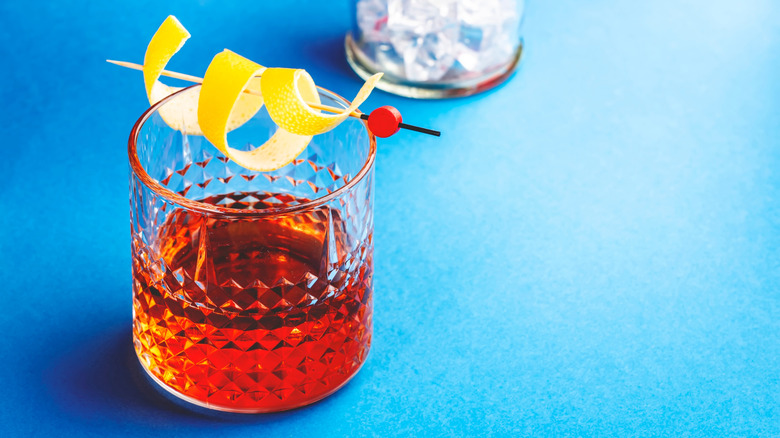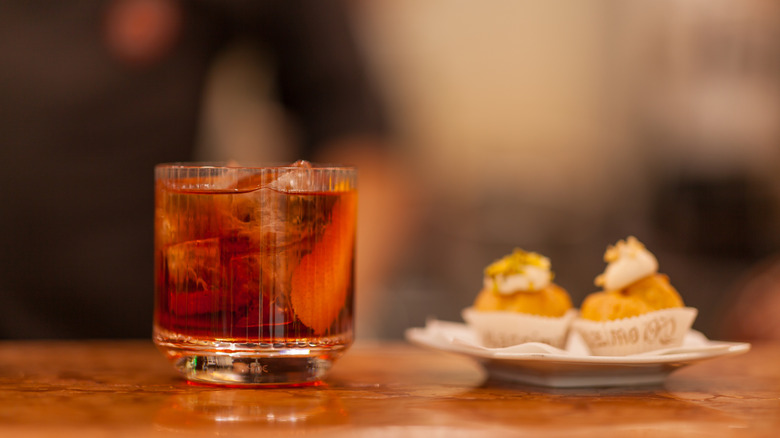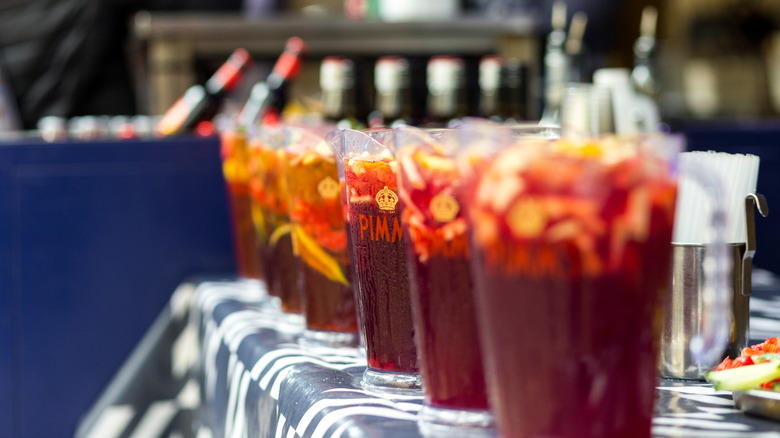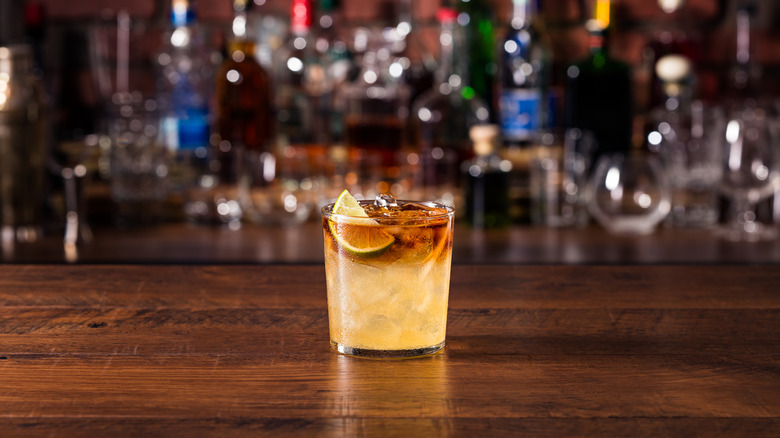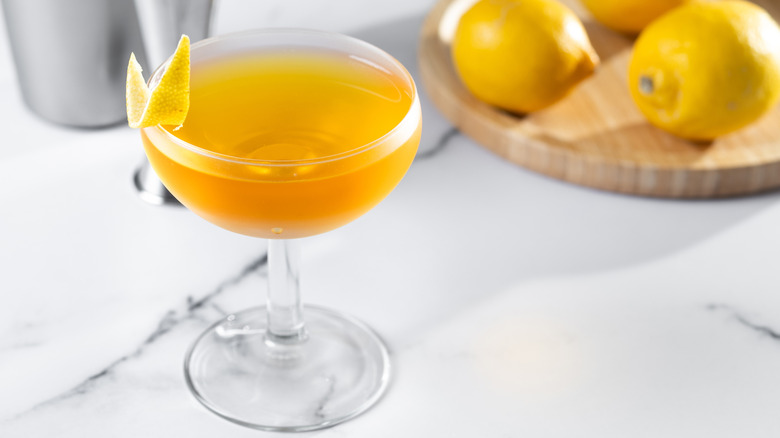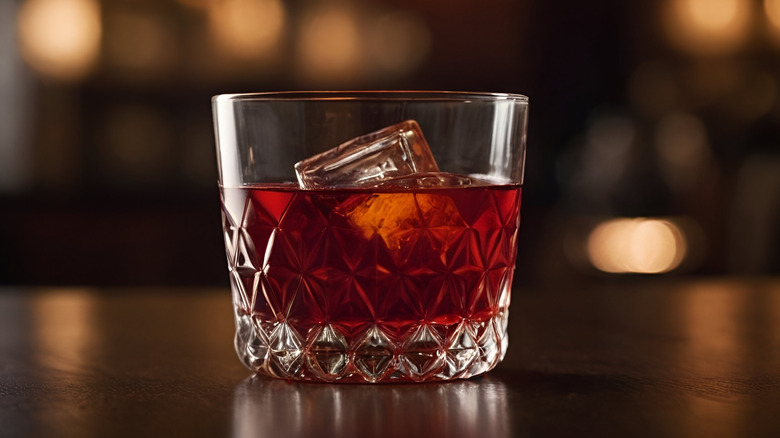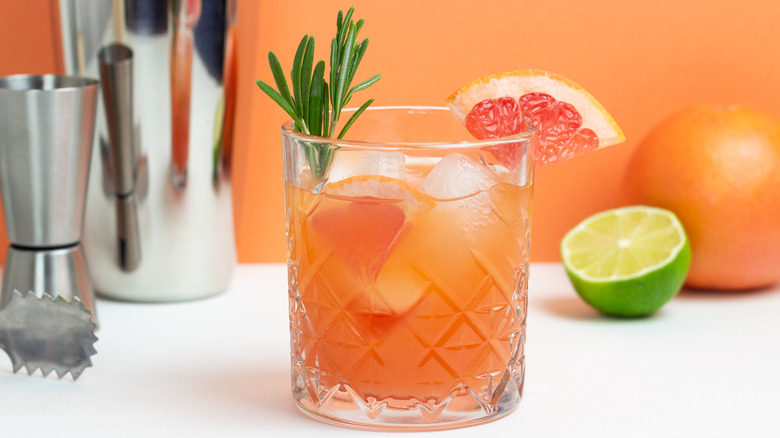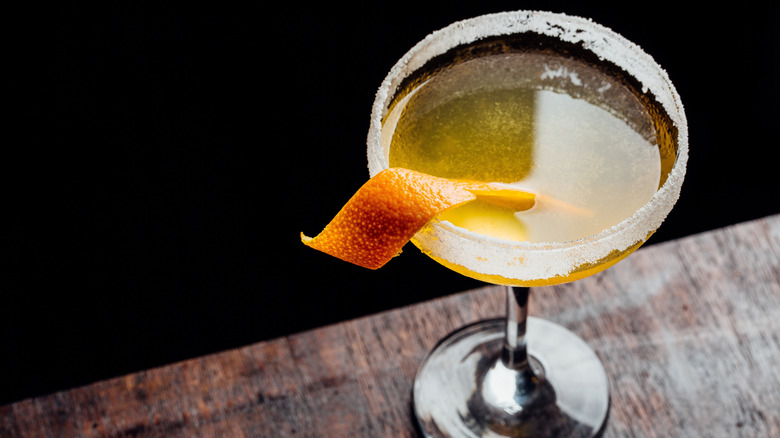Underrated Cocktails You Should Order More Often
Faced with a bewildering choice of drinks, some with the oddest of names, it's tempting to stick to the tried and true when you're at a bar. After all, ordering something new can be a risk. But stepping out of your comfort zone doesn't have to be that intimidating — especially when you know a little more about what to expect. In fact, trying something new can be surprisingly rewarding and give you a chance to expand your palate. Not to mention, the bartender and your friends are bound to be impressed as well.
Speaking of bartenders, they are usually your best resource. Most are full of helpful suggestions and happy to guide you on your merry way down the lesser-known cocktail route. Remember the golden rule: Playing it safe never made anyone the life of the party. Armed with this list of underrated cocktails, you're well on your way to claiming that title for yourself!
Tinto de Verano
Tinto de verano (or "summer red wine" in Spanish) is a century-old cocktail recipe designed to beat the heat. This cool drink, based around red wine, is cooling and fruit-forward without being too sweet. In Spain, it is made with either 'limón or soda blanca' (lemon or plain soda), and the ratio of wine to soda can vary depending on personal preference.
In the U.S., some recipes call for blending Sprite with fresh lemon and lime juice, while others use club soda for a drier finish. But regardless of the combination, the secret to getting it right lies in the garnish. Tinto de verano is what it is because of the citrus hits and bright taste from the lemon, lime, or orange used. This also helps balance the richness of the wine. Less well-known in the U.S. as compared to its more famous Spanish cousin, sangria, you will find tinto de verano in bars and restaurants that serve Spanish fare.
Vesper
A very controversial drink that is frequently dismissed by cocktail purists is the Vesper. It's made with gin and vodka — a blend rarely seen together in most classic recipes – and combining them in one glass has always raised eyebrows. That's what makes the Vesper so compelling. The original recipe calls for three parts gin, one part vodka, and a half measure of Kina Lillet, shaken, with a slice of lemon peel added. Its moment of glory came when James Bond ordered one in "Casino Royale," and even though author Ian Fleming wrote it into existence, he ironically referred to it as unpalatable.
The Vesper has its share of fans as well. Many appreciate it as a gateway for vodka drinkers to explore the world of gin. Vodka softens gin's sharper botanical notes and makes it a more appealing drink for the newbies. Whether you're a fan of James Bond or just curious about this unlikely combination, it might pleasantly surprise you.
Vodka Gimlet
A variation on the classic gimlet, the vodka gimlet replaces the gin with vodka and brings its own unique charm to the table. Not dependent on gin's floral notes, vodka acts as a neutral canvas for lime to become the natural focus. The proportions can be tweaked to suit individual tastes, making it a flexible favorite and one that is quite easy to make.
The original gimlet is believed to be an invention of the Royal Navy, but the vodka gimlet came into vogue in the 1970s when the popularity of vodka began to rise. The original version of the vodka gimlet used vodka, lime juice, and simple syrup. Today, mixologists sometimes use flavored vodka or vodka infused with fruits and herbs to give the cocktail a more modern spin. While the gimlet may seem a bit of an old-fashioned drink, its vodka sibling seems fresher, lighter, and more aligned with today's cocktail culture.
Rusty Nail
A simple combination of whiskey and Drambuie creates this old-school Rusty Nail cocktail that reached peak popularity during the 1970s. The proportions are flexible and entirely up to personal taste. Tweak the ratio of whisky to Drambuie if it's too overpowering or add a tad less liqueur (which is naturally sweeter) if you prefer your drinks more potent. It is, in fact, the perfect combination of the sweet liqueur and robust whiskey that sets this cocktail apart and will make you fall in love with it.
The drink first made an appearance around 1937 at the British Industries Fair in New York, but only became really popular in the late 1950s and 1960s. Its true heyday came in the 70s, especially at spots like the iconic Club 21 in New York, where it was a staple. Since then, its stardom has faded, but it still makes an occasional appearance on menus. The next time you spot it, go ahead and order one, for history's sake — and maybe for your own.
Vieux Carré
A seriously underrated cocktail whose name many people are afraid to even say aloud lest they pronounce it wrong, the Vieux Carré is a compelling blend of whiskey, cognac, vermouth, Bénédictine, Peychaud's, and Angostura bitters. One Reddit user aptly describes it as a drink that "takes the best parts of half a dozen classics and blends them together into something even greater than the sum of its many parts." In other words, the ingredients balance each other out perfectly while accentuating the cognac flavors.
The name Vieux Carré (pronounced VOO-kar-A, by the way) is French for "old square," a nod to its birthplace — the French Quarter of New Orleans. It was created in the Hotel Monteleone's Carousel Bar in 1938. Of late, however, it has slipped in popularity. Ordering one will express a nuanced appreciation for the bartender's skills while also subtly identifying yourself as someone with a finer appreciation of cocktails, who values balanced flavors. It's a subtle and easy way to up your cocktail game and impress the bartender.
Gin Rickey
In essence, the Gin Rickey is a Tom Collins minus the sugar and made with lime instead of lemon. Its name derives from Colonel Joe Rickey, a Civil War veteran turned Washington lobbyist, who is credited with inventing the drink. A fantastic summertime drink, it survived the trials of the Prohibition era largely because its refreshing flavor was preferable to plain drinking water.
Although originally a whiskey-based cocktail, the modern-day gin version is quite popular. Variations with licorice and other spicy additions can inject an additional fizz, but the lime is the star of the show. Its tartness balances out the richness of the gin and makes the palate pay attention. The Gin Rickey continues its evolutionary journey, with more adventurous bars experimenting with the classic formula and offering new, unique flavor profiles. For the daring cocktail nerd, this is just the drink to spice things up.
Sloe Gin Fizz
Sloe gin started as a gin that was infused with sloe berries, to which sugar was added to create a liqueur. Unfortunately, for various commercial reasons, most of the American versions available aren't even made of gin, but we digress. The classic Sloe Gin Fizz recipe calls for a good sloe gin such as Plymouth Sloe Gin, some lemon juice, sugar, and club soda. The fizz is usually served sans ice, in a glass that is shorter than a Collins glass.
It is a favorite of those looking for a pick-me-up after a night of indulgence or for cooling down during a hot summer. Some bartenders may cut corners, using artificial flavorings or subpar sloe gin that's not even distilled from real berries. If you want the true experience, seek out a bar that uses the good stuff, preferably from a craft distillery. If it's a stiffer drink you need, ask for it to be fortified with a splash of your favorite gin.
Aviation
A pale blue cocktail that is a mix of gin, lemon juice, maraschino, and crème de violette, the Aviation is a drink people love or love to hate, mainly on account of its floral bouquet. It's a classic pre-Prohibition cocktail and has enjoyed a resurgence in popularity that peaked around 2010. Its critics have ensured that it remains an underrated cocktail, and though it's even been included in a lists of overrated cocktails, loyal fans would beg to differ.
The fact is that the Aviation is a difficult drink to get right. The combination leaves room for very little error, and crème de violette isn't the easiest liqueur to come by, probably why so many bartenders prefer to omit it altogether. It does, however, give the drink its signature, delicate floral quality that cocktail aficionados love. But without it, you're essentially left with a dressed-up gin sour. When properly balanced, the Aviation is a delicate, elegant drink and one that deserves more respect than it gets.
Lemon Drop Cocktails
Vodka-based cocktails with a little twist, lemon drops are a little sweet, a little sour, and very boozy — perfect for a summer's day chilling by the pool or beach. First believed to have been created in the 1970s in San Francisco, the combination of vodka with citrus and sugar was an instant hit with patrons. The Lemon Drop remains a popular drink at college bars and nightclubs, and is still a great way to get a party started — no surprise there, given its vodka base. Served in a sugar-rimmed cocktail glass or a shot glass, as the younger crowd prefers it, it sets the right tone for a lively night.
The cocktail lends itself to experimentation. Many bartenders add a twist by using berry or citrus-flavored vodka or a dash of elderflower liqueur to give it a more complex and refined flavor. We do recommend that you try the original version before getting into the variations. After all, it's a classic for a reason.
Sazerac
In the rapidly evolving world of drinking culture, the Sazerac is a standout because it tends to be made inconsistently. While it is definitely not as well-known as a Manhattan or a martini, the Sazerac has been on the comeback trail with its tag of being the official cocktail of New Orleans.
So what goes into a Sazerac? Well, it is one of the oldest cocktails around, and the complex drink demands some finesse. Two main versions of this drink exist, each with a deep-rooted history behind the choices of preferred base spirit. One is based around cognac and the other around rye. A single dash of Angostura bitters is one of the cardinal rules, but as for the don'ts? Don't shake it. Don't serve it on the rocks. Don't use a cocktail glass. The list goes on — and don't upset the purists by veering far from any of these rules. In short, this isn't a drink to casually whip up at home. Instead, seek it out at a bar that takes its cocktails seriously. The Sazerac is an experience best savored at the hands of a pro.
Americano
First served in the 1860s at Gaspare Campari's bar in Milan, the Americano is a classic Italian cocktail made with Campari and sweet vermouth, topped with sparkling water. Its other claim to fame is being the first drink ordered by James Bond in the movie "Casino Royale."
Think of it as a less boozy version of the Negroni. The Americano can be considered more conducive to an easy afternoon libation, with the gin being substituted with club soda. To those who might add, "Where's the fun in that?" we say, look at the bright side. You can fearlessly cool down with a few without fear of getting too inebriated. Its fresh and bittersweet flavor makes it a wonderful summer drink, and there is something charmingly old-world about it with its simple ingredients that effortlessly balance each other. One word of caution: The Americano is only as good as what you put into it. Avoid substituting the Campari and use fresh vermouth for a cocktail that can revive and restore with every sip.
Pimm's Cup
A very popular summer drink in England, the Pimm's Cup is still relatively unknown in the U.S. However, if you are a fan of Wimbledon, you may have noticed the crowds sipping on a fruity pink drink while watching the courts. This sophisticated summer drink is made of a gin-based liqueur (known as Pimm's No.1 Cup), which has the Queen's seal of approval.Being British (and quite posh at that) gives it an undeniable "cool factor". The cocktail itself is made from Pimm's No.1, lemon juice, club soda, and a whole load of fruits and herbs added as garnishing. Light, citrusy, and herbaceous, it's a wonderfully refreshing option for warmer-weather soirees.
A word about Pimm's: It's easily available in liquor stores, usually alongside the liqueurs and cordials. While rarely enjoyed by itself, it comes into its own as a cocktail. At 50-proof, it's gentler than most American spirits (which are typically around 80-proof), making it a blessing, especially if you are planning to drink outdoors and under the sun. So next time you're bar hopping, consider branching out with a Pimm's Cup. This easygoing cocktail might just earn a permanent spot in your summer drink rotation.
Dark 'n' Stormy
Sounding like a cross between a blues song and a moody psych thriller, the Dark 'n' Stormy is, in fact, a refreshing summer cocktail. Made from a mix of lime, dark rum, and ginger beer, this cocktail goes down nice and easy, but don't be fooled — the rum packs quite a punch. It also happens to be the national drink of Bermuda, and those guys really know their rum!
It may not have the same appeal as its older and more famous sibling, the Moscow Mule, but for those in the know, it is by far the better choice. The flavor depends heavily on the proportions and, importantly, the rum. Purists insist on using Gosling's Black Seal rum, as it was the brand that originally created the drink. Of course, Gosling's ginger beer is also a must. The lime juice is an optional component. Why this cocktail isn't more popular remains something of a mystery, but for those who like their drinks with depth and a bit of drama, the Dark 'n' Stormy is a must-try.
Paper Plane
Invented in 2008 by NYC bartender and mixology master, Sam Ross, at the Violet Hour bar in Chicago,the paper plane is an underrated classic that's worth a try. Made up of bourbon, Amaro Nonino, Aperol, and lemon juice, it has the perfect balance of bitter and sweet. Though it was originally made using Campari, Ross decided to substitute it with Aperol to balance the flavors. Still somewhat underrated, this cocktail has been steadily climbing in popularity and has all the makings of being a star on the cocktail charts soon.
With a complex and sophisticated flavor profile, connoisseurs love this unusual cocktail, and it's found a spot on many high-end bar menus. Its versatility makes it suitable as both a pre- and post-dinner drink, as the Aperol acts as an aperitif and the Amaro Nonino, a digestif. So this summer, raise your cocktail game and impress your bartender by asking for a paper plane.
Boulevardier
Many bartenders will agree that the Boulevardier is one of the more underrated whiskey cocktails around. It's very similar to the better-known Negroni, but with bourbon instead of gin, and it has a wonderful balance between the bourbon, Campari, and vermouth. Garnished with an orange twist, it is sweet, bitter, and dry, all at once.
The Boulevardier is one of those old-school cocktails that's often overshadowed by its more famous relatives. It has a smoky and slightly spicy profile, courtesy of the bourbon used, which sets it apart. It's a darker, richer red-orange color compared to the Negroni that hints at its depth. Try it with a rye whiskey for a spicier edge and to discover a perfect flavor profile for your palate. The best part, for some, about this cocktail is the subtle comforting flavor and warmth it imparts. It's the kind of classic you'll want to sip on a cold winter's night.
Paloma
The lesser-known compatriot of the margarita, the Paloma is another tequila-based cocktail courtesy of our Mexican neighbors. Made with a mix of blanco tequila, lime juice, and grapefruit soda, its citrusy flavor and fizzy effervescence make it a refreshing choice on a hot summer day. If you're feeling adventurous and want to elevate your cocktail game, try swapping the tequila for mezcal.
With tequila and mezcal becoming trendier by the day, the Paloma, too, should soon be claiming its place in the spotlight. This is especially true among the younger crowd with a preference for craft drinks. Many variations have also been created, with blood orange replacing grapefruit, fruits like cranberry and pomegranate being added, and in some cases, even Peruvian Pisco standing in for tequila. So the next time you're out partying, level up your bar order and ask for a Paloma instead.
Sidecar
As any bartender worth their bitters will tell you, the Sidecar is a delightful Prohibition-era cocktail that's surprisingly refreshing. Yet, it's rarely ordered, perhaps because of the many permutations of how it's made.
First, the drink. Made from a mix of cognac, Cointreau, and lemon juice (in varying proportions), the Sidecar's origins are still mysterious. The French version calls for equal amounts of all three ingredients. Naturally, the English have to differ: Their version uses two parts brandy to one part each of Cointreau and lemon juice. Ever-helpful Reddit users also recommend adding a bit of sugar for balance. So, how do you decide which version to try? We say, let the quality of the ingredients decide that for you. Whatever the drawbacks and difficulties in making the ideal Sidecar, every cocktail lover owes it to themselves to try a Sidecar at least once — if only to broaden their boozy horizons.
